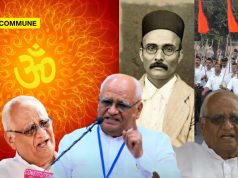
Velu Nachiyar stands out as one of the earliest rulers from Tamilagam who bravely fought the East India Company and succeeded against the might of the British onslaught through her valour and intelligence. She kept the Sivagangai Samasthanam free from Company rule until she was alive, a feat rarely matched by her contemporary rulers. She was a perfect example of ‘Nari Sakthi.’
Born in the royal family of Ramanathapuram Sethupathis, Velu Nachiyar was the only daughter of Sellamuthu Vijaya Raghunatha Sethupathi and Muthammal. Sethupathi trained her in martial arts like Valari and Silambam, and she learnt several languages, including English, French, and Urdu. It was common for those in Ramanathapuram to see her riding a horse and practising sword fighting with the guards. She married Muthu Vaduganatha Thevar of Sivagangai Samasthanam and became a queen. However, she didn’t forget her roots. She made the logo of Sivagangai similar to that of Ramanathapuram with Hanuman and Garuda.
Things took a turn when Muthu Vaduganathar raised the flag of rebellion against the East India Company, who harassed him to pay the tax due to Arcot Nawab. Muthu Vaduganathar made Vijayakumaran as the Madurai Nayak against the interests of Arcot Nawab and Company, which made them hate him further. Company forces attacked Sivaganga in 1772, and Muthu Vaduganathar fought bravely. However, when he went for a darshan at the Kalayar Kovil temple, he was assassinated by one of the soldiers in the British army. This made his army lose the battle against the Company forces, and Velu Nachiyar had to move away from the Kingdom.
Undeterred, she took the help of the Marudhu Brothers, who were commanders of Muthu Vaduganathar, and Thandavarayan Pillai, a close associate of Muthu Vaduganathar. They assembled an army of various Palayams. Hyder Ali had sent about 5000 army men. Many polygars unhappy with the Company’s growing dominance also sent their army to assist Velu Nachiyar. She slowly built her army, which included an exclusive division for women. She waited for about eight years to launch a counterattack, and the opportune moment came during the Vijayadasami day of 1780. The British placed restrictions on entering Sivaganga & only women were allowed to perform Pooja. A group of women entered the town to perform the Pooja. Suddenly, they took out their arms and started attacking the guards. Using the melee, Velu Nachiyar entered along with the Marudhu brothers and their army.
The British forces scattered and ran away, unable to withstand the sudden onslaught. Sivaganga was recaptured. Hanuma Dwaja, the flag of Hanuman, was hoisted on the ramparts of the fort. After successfully reclaiming the Samasthanam, she ruled for about ten years. Multiple attempts by the British to capture Sivaganga were foiled by her brave army. She had issued coins with Rama & Sita on one side and Sivalinga and Rishaba on the other side. She made several donations to the temples nearby. There is an inscription in the Sakkanthi Vinayagar temple that has her name as one of the donors: “The grant was made by Velu Nachiyar, who is the wife of Muthuvaduga Thevar of Sakkanthi.”
She had only a daughter ‘Vellachi Nachiyar’ and hence, she gave the administrative rights to the Marudhu Brothers in 1790 to govern the Sivagangai after her. She spent her last years in Viruppatchi near Dindugal and passed away in 1796. Marudhu brothers continued the legacy of freedom struggle and spearheaded the first rebellion against the British from South India. In the glorious history of Tamil Nadu’s contribution towards the Indian Freedom struggle, Velu Nachiyar finds an important place.
TS Krishnan is a Tamil scholar and author.
Subscribe to our channels on Telegram, WhatsApp, and Instagram and get the best stories of the day delivered to you personally.




